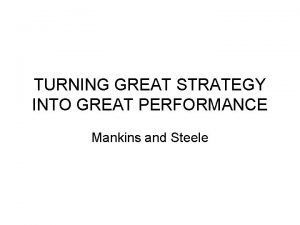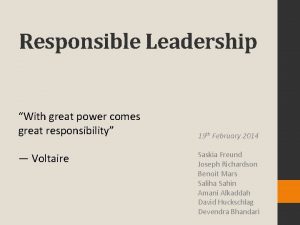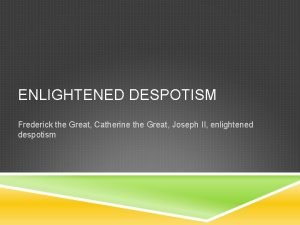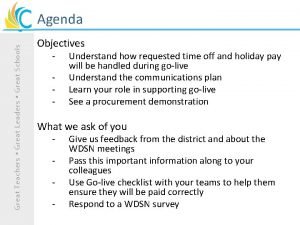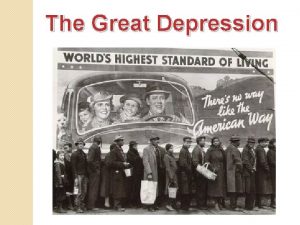Overview of Good to Great Good to Great
















- Slides: 16

Overview of Good to Great

Good to Great The commonalities between all the good to great companies: • Level 5 leadership • First who… Then what • Confront the Brutal facts (yet never lose faith) • The Hedgehog Concept (simplicity within the three circles) • A culture of Discipline • Technology Accelerators • The Flywheel and the Doom loop • From Good to Great to Built to Last

Level 5 leadership Level 5 leaders: • Were at the head of all the good to great companies during their transition from good to great • Are characterized by personal humility while still remaining professionally ambitious with their ambition being for the organizations success before their own success • They are exceedingly modest while the leaders of the comparison companies were egocentric and self-centered • Are fanatically driven for to see sustained success while level 4 leaders are only focused on their personal achievements

Level 5 leadership Level 5 leaders: • • Do whatever it takes to make the company great Are more plow horse than show horse Attribute success to others rather than themselves Set up the leaders that came after them for success while level 4 leaders set the leader that took their place up for failure • Most companies in trouble look for the celebrity CEO to swoop in and save the day instead of hiring a level 5 leader

When in doubt, don’t hire-keep looking • No company can grow revenues faster than its ability to get enough of the right people • To Build great companies its not about MARKETS, TECHNOLOGY, COMPETITION • ABITLITY TO GET AND KEEP PEOPLE!! • Invest in the right people from the beginning.

Confront the Brutal Facts • Good-to-Great Companies confront the brutal facts of their current realities • With honest and diligent efforts; right decisions are self-evident • People should be allowed to be heard; truth should be heard

Confront the Brutal Facts • Hit realities head-on; emerge from adversity stronger • Retain faith that you can and at the same time confront the most brutal facts • Be careful with charisma; liability or asset • If you have the right people, they will be selfmotivated

The Hedgehog Concept • The key is to understand what your organization can be the best in the world at, and equally important what is cannot be the best at-not what it “wants” to be the best at. • Not a goal, strategy, or intention; it is an understanding • To get insight into the drivers of your economic engine, search for the one denominator that has the single greatest impact. • Each good-to-great company built a great economic engine, regardless of the industry • Good-to-great companies set their goals and strategies based on understanding

• It took four years on average for companies to get a Hedgehog Concept

Denominator Question • If you could pick one and only one ration—profit per x– to systematically increase over time, what x would have the greatest and most sustainable impact on your economic engine? • Serves as a mechanism to force deeper understanding of the key drivers in your economic engine • The point of having the denominator is to gain insight which will ultimately lead to more robust and sustainable economics • Companies do not need to be in a great industry to become a great company

A Culture of Discipline • A culture of discipline involves a duality • It requires people to stick to a consistent system with clear constraints • It also has to give people freedom and responsibility within the framework of that system

A Culture of Discipline • A culture of discipline is not just about action. • It has to deal with building a culture full of disciplined people that engage in disciplined thought and then take a disciplined action • If you get the right people on the bus, and the wrong people off, you don’t need stultifying bureaucracy

A Culture of Discipline • The most essential form of discipline for sustained results is dedicated faithfulness to the Hedgehog Concept and the eagerness to reject opportunities that fall out side three circles

TECHNOLOGICAL ACCELERATIONS • Good to great organizations think differently about technology. • Good to great organizations avoid technology fads and bandwagons, yet they become pioneers in the application of carefully selected technologies.

Technological Acceleration • Technology as an Accelerator, Not a Creator, of Momentum • The Technological Trap • Technology and The Fear of Being Left Behind

Built to Last • Good to Great is a cumulative process that takes time to develop • Analogy of Profits and Cash as the blood and water to a healthy body • Enduring Great companies adapt with change while keeping core values and purpose intact
 Good thoughts good deeds good words
Good thoughts good deeds good words Hello everyone good evening
Hello everyone good evening Good afternoon animado
Good afternoon animado If you are
If you are Good afternoon students
Good afternoon students Turning great strategy into great performance
Turning great strategy into great performance South dakota state animal
South dakota state animal With great leadership comes great responsibility
With great leadership comes great responsibility Great white shark vs great hammerhead
Great white shark vs great hammerhead Does alexander the great deserve his title
Does alexander the great deserve his title Enlightened despot catherine
Enlightened despot catherine With great expectations comes great responsibility
With great expectations comes great responsibility A great deal vs a great many
A great deal vs a great many With great power comes great responsibility batman
With great power comes great responsibility batman Does alexander deserve to be called the great
Does alexander deserve to be called the great Oh god my father how great great is your faithfulness
Oh god my father how great great is your faithfulness Www overview
Www overview





